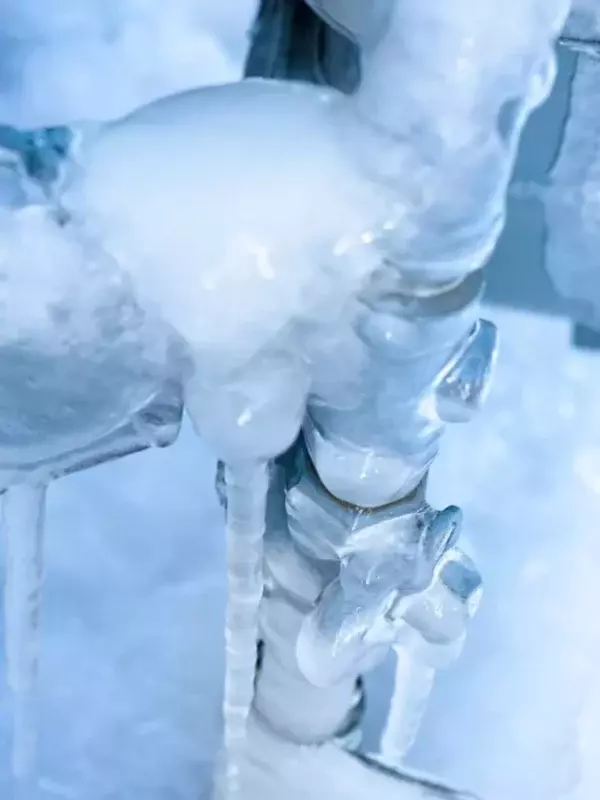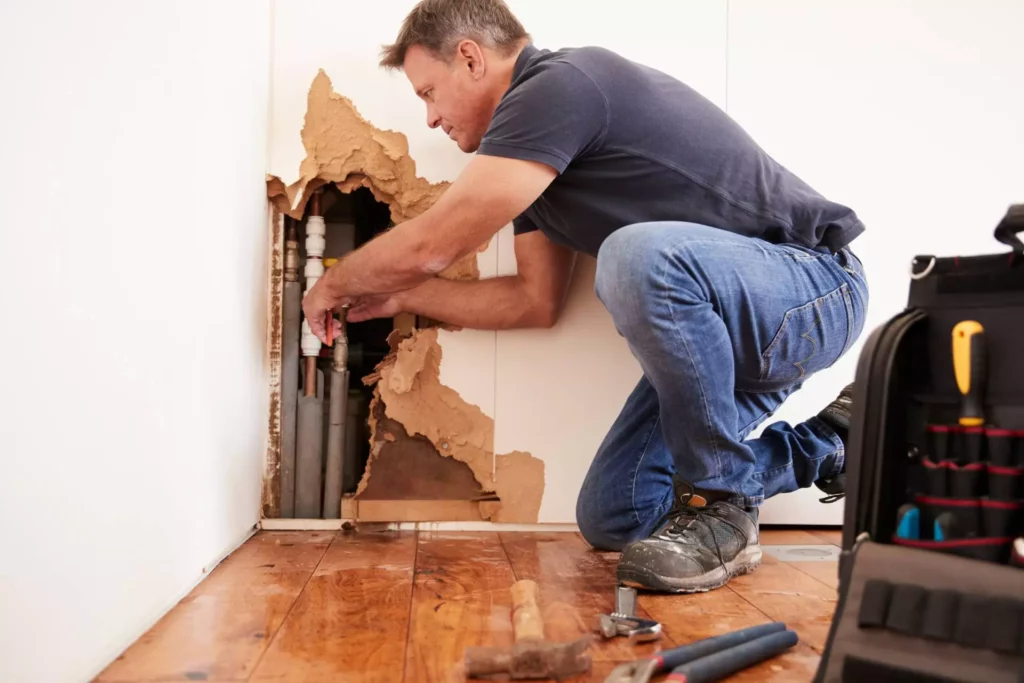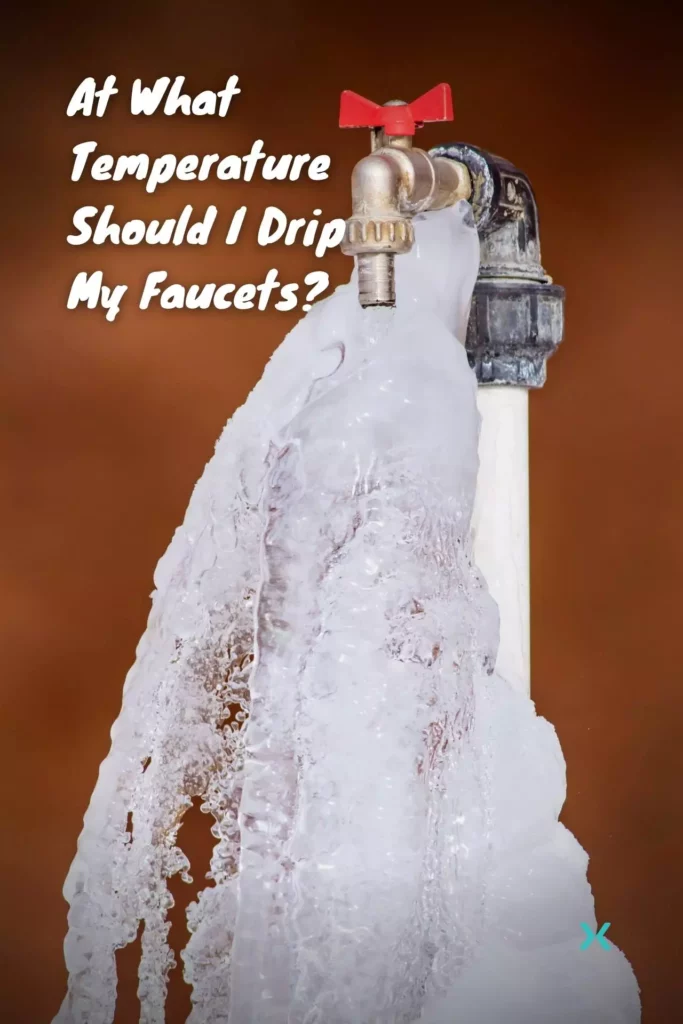💧 Yes, You Should Let Your Faucets Drip In Freezing Water!
In winter, temperatures can drop below freezing. For homeowners, this means that water pipes can freeze and potentially burst.
To prevent this from happening, many people “drip” their faucets during the cold season – but at what temp should I drip my faucets?
Let’s explore!
Table of Contents
💧 Why Frozen Pipes are a Problem

Freezing temperatures can cause pipes to freeze and burst, leading to major plumbing issues in homes.
Cold water pipes that freeze are prone to bursting when the temperature of the water inside them falls below 32◦F (0◦C). When this happens, water pressure builds up within the pipe, which could lead to a rupture and flooding of your home.
This pressure puts significant pressure on the inside of your pipe regardless of the type, including metal or plastic pipes.
In addition to water damage, a burst pipe can lead to mold growth and property damage caused by ruined insulation and drywall.
To avoid this problem, homeowners should ensure their homes are well-insulated in cold weather and take steps such as turning off any outdoor spigots or draining exposed pipes after every use.
According to the Insurance Information Insitute, 19.9% of Homeowners’ Insurance Losses in 2020 were caused by water damage and freezing.
📗 Related Reading: How To Winterize Pipes to Protect Your Home
Protect Pipes in Outdoor and Unheated Areas

Homeowners should take precautions to protect pipes in outdoor areas and unheated spaces, especially when temperatures drop.
Outdoor pipes are vulnerable to freezing due to their lack of insulation and can quickly burst if the temperature drops below 32◦F (0°C).
Unheated places such as basements, attics, garages, and crawl spaces are also at risk for frozen pipes due to cold air seeping through walls or openings.
Opening kitchen and bathroom cabinets during freezing weather allows for circulating warm air to keep your pipes warm.
To prevent this problem, homeowners should insulate exposed pipes with foam pipe sleeves, install heated cables around outdoor spigots, and seal up any openings where cold air could enter an unheated area.
Installing outdoor freeze-proof faucets and hydrants can also prevent frozen pipes.
These steps can help ensure that plumbing systems stay safe and functioning during winter.
At What Temperature Should I Drip My Faucets?
The exact temperature at which you should start dripping your faucets varies based on location and climate.
Generally speaking, it is recommended that you start dripping your faucets when temperatures reach 20°F (-7°C) or below.
If temperatures are expected to stay at these levels or lower for extended periods (two weeks or more), adding insulation around uninsulated pipes is also recommended as an extra precautionary measure.
You should also drain or winterize your outdoor plumbing, including any water sprinkler supply lines and swimming pool supply lines you might have.
How Much Water Should Drip To Keep Pipes From Freezing
No need to run the faucet at full blast. 5 to 10 drops a minute will achieve the same result.
Also, find the faucet at the furthest distance from the water meter and let it drip.
How Long Should I Keep Dripping My Faucets?
You should continue to drip your faucets until temperatures rise above freezing again and consistently stays there, especially at night.
As mentioned above, if temperatures are expected to remain low for extended periods, you may need to continue dripping for longer than usual—up to several weeks—to ensure that all of the water in the pipes does not freeze solid and cause a pipe burst.
Do Frozen Pipes Always Burst?
A frozen pipe does not always burst, but the risk of rupture is significantly higher when pipes freeze.
A pipe will only burst if the pressure builds up to a sufficient level – this typically happens when the water inside the pipe freezes and expands.
In some cases, however, water can partially freeze within a pipe without causing a rupture.
How Long Does It Take For Pipes To Freeze?
Generally, it takes between six and twelve hours for a pipe to freeze in temperatures of 20°F (-7°C) or lower.
However, if temperatures are significantly colder, this time frame could be reduced to as little as two hours.
It is important to note that unprotected pipes are more vulnerable to freezing at lower temperatures, so the danger should not be underestimated even when the thermometer reads above 20°F (-7°C).
How Do You Find a Frozen Water Pipe?
Finding a frozen water pipe may be challenging, especially if the source of the freeze is in an inaccessible area.
If you hear a loud bang, that’s probably a frozen pipe bursting.
Before that happens, go around your home and check each faucet for additional frozen pipes.
If only a trickle comes out, that’s probably your frozen pipe.
If this isn’t successful, homeowners can use a thermometer or infrared camera if you have one to detect temperature changes along the length of their pipes.
If any sections remain significantly colder than other areas, then it is likely that a section of pipe has frozen.
What Is The Quickest Way To Thaw Frozen Pipes?
Thawing frozen pipes is a relatively simple process that can be achieved in several ways.
The most popular option is to use an electric heating pad wrapped around the affected section of the pipe.
Setting the pad’s temperature to just above freezing will help gradually thaw the pipe without causing damage.
Homeowners may opt for hot water bottles, an electric hair dryer, a portable space heater, or towels soaked in warm water and draped around the pipe when electric warmers are unavailable.
Conclusion

By implementing drip-temperature management when temperatures drop below 20°F (-7°C), homeowners can significantly reduce their risk of experiencing a pipe burst due to frozen plumbing systems.
Insulating exposed pipes is also recommended for extra protection against freezing temperatures.
Remember, it’s better to be safe than sorry!
These simple steps can save you from costly repairs later on down the line and prevent your pipes from freezing in the short term.

